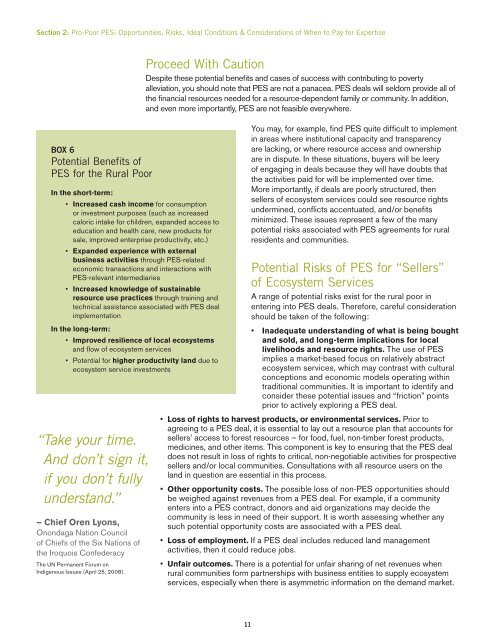Payments for Ecosystem Services: Getting Started. A Primer - UNEP
Payments for Ecosystem Services: Getting Started. A Primer - UNEP
Payments for Ecosystem Services: Getting Started. A Primer - UNEP
You also want an ePaper? Increase the reach of your titles
YUMPU automatically turns print PDFs into web optimized ePapers that Google loves.
Section 2: Pro-Poor PES: Opportunities, Risks, Ideal Conditions & Considerations of When to Pay <strong>for</strong> Expertise<br />
BOX 6<br />
Potential Benefits of<br />
PES <strong>for</strong> the Rural Poor<br />
In the short-term:<br />
• Increased cash income <strong>for</strong> consumption<br />
or investment purposes (such as increased<br />
caloric intake <strong>for</strong> children, expanded access to<br />
education and health care, new products <strong>for</strong><br />
sale, improved enterprise productivity, etc.)<br />
• Expanded experience with external<br />
business activities through PES-related<br />
economic transactions and interactions with<br />
PES-relevant intermediaries<br />
• Increased knowledge of sustainable<br />
resource use practices through training and<br />
technical assistance associated with PES deal<br />
implementation<br />
In the long-term:<br />
• Improved resilience of local ecosystems<br />
and fl ow of ecosystem services<br />
• Potential <strong>for</strong> higher productivity land due to<br />
ecosystem service investments<br />
“ Take your time.<br />
And don’t sign it,<br />
if you don’t fully<br />
understand.”<br />
— Chief Oren Lyons,<br />
Onondaga Nation Council<br />
of Chiefs of the Six Nations of<br />
the Iroquois Confederacy<br />
The UN Permanent Forum on<br />
Indigenous Issues (April 25, 2008).<br />
Proceed With Caution<br />
Despite these potential benefi ts and cases of success with contributing to poverty<br />
alleviation, you should note that PES are not a panacea. PES deals will seldom provide all of<br />
the fi nancial resources needed <strong>for</strong> a resource-dependent family or community. In addition,<br />
and even more importantly, PES are not feasible everywhere.<br />
You may, <strong>for</strong> example, fi nd PES quite diffi cult to implement<br />
in areas where institutional capacity and transparency<br />
are lacking, or where resource access and ownership<br />
are in dispute. In these situations, buyers will be leery<br />
of engaging in deals because they will have doubts that<br />
the activities paid <strong>for</strong> will be implemented over time.<br />
More importantly, if deals are poorly structured, then<br />
sellers of ecosystem services could see resource rights<br />
undermined, confl icts accentuated, and/or benefi ts<br />
minimized. These issues represent a few of the many<br />
potential risks associated with PES agreements <strong>for</strong> rural<br />
residents and communities.<br />
Potential Risks of PES <strong>for</strong> “Sellers”<br />
of <strong>Ecosystem</strong> <strong>Services</strong><br />
A range of potential risks exist <strong>for</strong> the rural poor in<br />
entering into PES deals. There<strong>for</strong>e, careful consideration<br />
should be taken of the following:<br />
• Inadequate understanding of what is being bought<br />
and sold, and long-term implications <strong>for</strong> local<br />
livelihoods and resource rights. The use of PES<br />
implies a market-based focus on relatively abstract<br />
ecosystem services, which may contrast with cultural<br />
conceptions and economic models operating within<br />
traditional communities. It is important to identify and<br />
consider these potential issues and “friction” points<br />
prior to actively exploring a PES deal.<br />
• Loss of rights to harvest products, or environmental services. Prior to<br />
agreeing to a PES deal, it is essential to lay out a resource plan that accounts <strong>for</strong><br />
sellers’ access to <strong>for</strong>est resources — <strong>for</strong> food, fuel, non-timber <strong>for</strong>est products,<br />
medicines, and other items. This component is key to ensuring that the PES deal<br />
does not result in loss of rights to critical, non-negotiable activities <strong>for</strong> prospective<br />
sellers and/or local communities. Consultations with all resource users on the<br />
land in question are essential in this process.<br />
• Other opportunity costs. The possible loss of non-PES opportunities should<br />
be weighed against revenues from a PES deal. For example, if a community<br />
enters into a PES contract, donors and aid organizations may decide the<br />
community is less in need of their support. It is worth assessing whether any<br />
such potential opportunity costs are associated with a PES deal.<br />
• Loss of employment. If a PES deal includes reduced land management<br />
activities, then it could reduce jobs.<br />
• Unfair outcomes. There is a potential <strong>for</strong> unfair sharing of net revenues when<br />
rural communities <strong>for</strong>m partnerships with business entities to supply ecosystem<br />
services, especially when there is asymmetric in<strong>for</strong>mation on the demand market.<br />
11
















